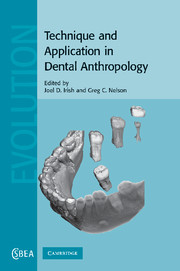Book contents
- Frontmatter
- Contents
- Contributors
- Acknowledgments
- Section I Context
- Section II Applications in assessing population health
- 4 Using perikymata to estimate the duration of growth disruptions in fossil hominin teeth: issues of methodology and interpretation
- 5 Micro spatial distributions of lead and zinc in human deciduous tooth enamel
- 6 The current state of dental decay
- 7 Dental caries prevalence by sex in prehistory: magnitude and meaning
- 8 Dental pathology prevalence and pervasiveness at Tepe Hissar: statistical utility for investigating inter-relationships between wealth, gender, and status
- Section III Applied life and population history
- Section IV Forefront of technique
- Index
- References
5 - Micro spatial distributions of lead and zinc in human deciduous tooth enamel
Published online by Cambridge University Press: 12 September 2009
- Frontmatter
- Contents
- Contributors
- Acknowledgments
- Section I Context
- Section II Applications in assessing population health
- 4 Using perikymata to estimate the duration of growth disruptions in fossil hominin teeth: issues of methodology and interpretation
- 5 Micro spatial distributions of lead and zinc in human deciduous tooth enamel
- 6 The current state of dental decay
- 7 Dental caries prevalence by sex in prehistory: magnitude and meaning
- 8 Dental pathology prevalence and pervasiveness at Tepe Hissar: statistical utility for investigating inter-relationships between wealth, gender, and status
- Section III Applied life and population history
- Section IV Forefront of technique
- Index
- References
Summary
Introduction
Enamel is the hard crystalline external covering of teeth, and has a mineral component that closely resembles hydroxyapatite (Boyde, 1989; Brudevold and Soremark, 1967). The chemical constituents of hydroxyapatite are tolerant to substitution by a range of trace elements, and are readily incorporated into enamel formation at the time of environmental exposure. The composition of sub-surface enamel is fixed before tooth emergence, and is therefore able to provide a retrospective and relatively permanent record of the trace elements absorbed during the period of enamel formation. The information locked within this deep enamel can provide evidence of early nutrition, residential mobility, and exposure to toxic metals. The incorporation of some trace elements into enamel hydroxyapatite also has the potential to affect susceptibility to caries. The trace element composition of enamel has a broad relevance in disciplines ranging from dentistry and child health (Brown et al., 2004; Dolphin et al., 2005) to forensics (Gulson et al., 1997a) and archaeology (Budd et al., 2000). Two trace elements of particular interest are lead (Pb) and zinc (Zn).
Lead toxicity remains a major public health concern, particularly in relation to its neurological effects on infants and young children (Bellinger et al., 1984; Goyer, 1996). Lead enters the body from contaminated food and drinking water, and inhaled air and dust, and accumulates gradually in calcified tissues. Non-food sources include lead emissions from gasoline, smelter emissions, lead-based paints and glazed food containers (Jarup, 2003).
- Type
- Chapter
- Information
- Technique and Application in Dental Anthropology , pp. 87 - 110Publisher: Cambridge University PressPrint publication year: 2008
References
- 8
- Cited by



